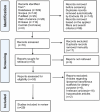A systematic review of liposomal nanofibrous scaffolds as a drug delivery system: a decade of progress in controlled release and therapeutic efficacy
- PMID: 39727310
- PMCID: PMC11703383
- DOI: 10.1080/10717544.2024.2445259
A systematic review of liposomal nanofibrous scaffolds as a drug delivery system: a decade of progress in controlled release and therapeutic efficacy
Abstract
Drug-loaded liposomes incorporated in nanofibrous scaffolds is a promising approach as a multi-unit nanoscale system, which combines the merits of both liposomes and nanofibers (NFs), eliminating the drawback of liposomes' poor stability on the one hand and offering a higher potential of controlled drug release and enhanced therapeutic efficacy on the other hand. The current systematic review, which underwent a rigorous search process in PubMed, Web of Science, Scopus, Embase, and Central (Cochrane) employing (Liposome AND nanofib* AND electrosp*) as search keywords, aims to present the recent studies on using this synergic system for different therapeutic applications. The search was restricted to original, peer-reviewed studies published in English between 2014 and 2024. Of the 309 identified records, only 29 studies met the inclusion criteria. According to the literature, three different methods were identified to fabricate those nanofibrous liposomal scaffolds. The results consistently demonstrated the superiority of this dual system for numerous therapeutic applications in improving the therapy efficacy, enhancing both liposomes and drug stability, and releasing the encapsulated drug in a proper sustained release without significant initial burst release. Merging drug-loaded liposomes with NFs as liposomal nanofibrous scaffolds are a safe and efficient approach to deliver drug molecules and other substances for various pharmaceutical applications, particularly for wound dressing, tissue engineering, cancer therapy, and drug administration via the buccal and sublingual routes. However, further research is warranted to explore the potential of this system in other therapeutic applications.
Keywords: controlled release; electrospinning; nanofibrous liposomal scaffold; oromucosal route; tissue engineering; topical cancer treatment.
Conflict of interest statement
No potential conflict of interest was reported by the authors.
Figures







Similar articles
-
Liposomal bupivacaine peripheral nerve block for the management of postoperative pain.Cochrane Database Syst Rev. 2016 Aug 25;2016(8):CD011476. doi: 10.1002/14651858.CD011476.pub2. Cochrane Database Syst Rev. 2016. PMID: 27558150 Free PMC article.
-
Liposomal bupivacaine infiltration at the surgical site for the management of postoperative pain.Cochrane Database Syst Rev. 2017 Feb 1;2(2):CD011419. doi: 10.1002/14651858.CD011419.pub2. Cochrane Database Syst Rev. 2017. PMID: 28146271 Free PMC article.
-
Systemic pharmacological treatments for chronic plaque psoriasis: a network meta-analysis.Cochrane Database Syst Rev. 2021 Apr 19;4(4):CD011535. doi: 10.1002/14651858.CD011535.pub4. Cochrane Database Syst Rev. 2021. Update in: Cochrane Database Syst Rev. 2022 May 23;5:CD011535. doi: 10.1002/14651858.CD011535.pub5. PMID: 33871055 Free PMC article. Updated.
-
Local anti-infective therapy: pharmacological agents. A systematic review.Ann Periodontol. 2003 Dec;8(1):79-98. doi: 10.1902/annals.2003.8.1.79. Ann Periodontol. 2003. PMID: 14971250
-
Systemic pharmacological treatments for chronic plaque psoriasis: a network meta-analysis.Cochrane Database Syst Rev. 2017 Dec 22;12(12):CD011535. doi: 10.1002/14651858.CD011535.pub2. Cochrane Database Syst Rev. 2017. Update in: Cochrane Database Syst Rev. 2020 Jan 9;1:CD011535. doi: 10.1002/14651858.CD011535.pub3. PMID: 29271481 Free PMC article. Updated.
Cited by
-
Preparing a Liposome-Aided Drug Delivery System: The Entrapment and Release Profiles of Doxorubicin and 9-(N-Piperazinyl)-5-methyl-12(H)-quino [3,4-b][1,4]benzothiazinium Chloride with Human Serum Albumin.Pharmaceutics. 2025 Feb 6;17(2):202. doi: 10.3390/pharmaceutics17020202. Pharmaceutics. 2025. PMID: 40006569 Free PMC article.
-
Centella asiatica: Advances in Extraction Technologies, Phytochemistry, and Therapeutic Applications.Life (Basel). 2025 Jul 9;15(7):1081. doi: 10.3390/life15071081. Life (Basel). 2025. PMID: 40724583 Free PMC article. Review.
-
Recent Advances in the Mechanisms and Applications of Astragalus Polysaccharides in Liver Cancer Treatment: An Overview.Molecules. 2025 Jun 28;30(13):2792. doi: 10.3390/molecules30132792. Molecules. 2025. PMID: 40649307 Free PMC article. Review.
References
-
- Angel N, Li S, Kong L. (2024). Emerging applications of nanofibers electrospun from carbohydrate polymers. J Future Foods 4:289–99. doi: 10.1016/j.jfutfo.2023.11.001. - DOI
Publication types
MeSH terms
Substances
LinkOut - more resources
Full Text Sources
Miscellaneous
